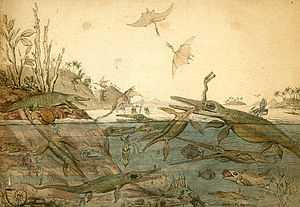Timeline of plesiosaur research
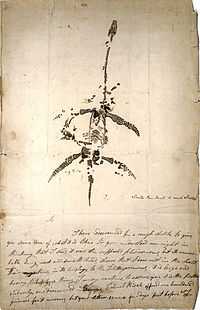
This timeline of plesiosaur research is a chronologically ordered list of important fossil discoveries, controversies of interpretation, taxonomic revisions, and cultural portrayals of plesiosaurs, an order of marine reptiles that flourished during the Mesozoic Era. The first scientifically documented plesiosaur fossils were discovered during the early 19th century by Mary Anning.[1] Plesiosaurs were actually discovered and described before dinosaurs.[2] They were also among the first animals to be featured in artistic reconstructions of the ancient world, and therefore among the earliest prehistoric creatures to attract the attention of the lay public.[3] Plesiosaurs were originally thought to be a kind of primitive transitional form between marine life and terrestrial reptiles. However, now plesiosaurs are recognized as highly derived marine reptiles descended from terrestrial ancestors.[4]
Early researchers thought that plesiosaurs laid eggs like most reptiles. They commonly imagined plesiosaurs crawling up beaches and burying eggs like turtles. However, later opinion shifted towards the idea that plesiosaurs gave live birth and never went on dry land.[5] Plesiosaur locomotion has been a source of continuous controversy among paleontologists.[6] The earliest speculations on the subject during the 19th century saw plesiosaur swimming as analogous to the paddling of modern sea turtles. During the 1920s opinion shifted to the idea that plesiosaurs swam with a rowing motion.[7] However, a paper published in 1975 that once more found support for sea turtle-like swimming in plesiosaurs.[8] This conclusion reignited the controversy regarding plesiosaur locomotion through the late 20th century.[9] In 2011, F. Robin O'Keefe and Luis M. Chiappe concluded the debate on plesiosaur reproduction, reporting the discovery of a gravid female plesiosaur with a single large embryo preserved inside her.[10]
Prescientific
Associated remains of plesiosaurs and animals like the diving bird Hesperornis or the pterosaur Pteranodon may have inspired legends about conflict between Thunder Birds and Water Monsters told by the Native Americans of Kansas and Nebraska.[11]
19th century
1811
- Mary Anning discovered the first scientifically documented plesiosaur fossils in England.[1]
- Henry De la Beche and Conybeare named the species Plesiosaurus dolichodeirus.[12]
- De la Beche illustrated a work titled "Duria Antiquior", meaning "Ancient Dorset" for fossil hunter Mary Anning. This work, which prominently features plesiosaurs, has been regarded as the first attempt to accurately reconstruct the Mesozoic world through an artistic medium.[3]
- von Meyer described Pistosaurus. Pistosaurus is believed to be a transitional form linking plesiosaurs to their nothosaur forebears.[13]
- Sir Richard Owen formally named the pliosaurs.[14]
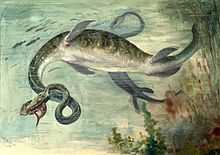
- Jules Verne depicted a relict plesiosaur's defeat in combat against an ichthyosaur in Journey to the Center of the Earth.[15]
- Harry Seeley mistakenly claimed to have discovered several fossil plesiosaur embryos.[16]
- F. W. Cragin named the genus and species Trinacromerum bentonianum from Kansas.[17]
- With guidance from Edward Drinker Cope, paleo-artist Charles R. Knight illustrated an Elasmosaurus platyurus eating a fish. The elasmosaur's neck was erroneously looped into an anatomically impossible figure 8 configuration that evoked the image of "a python grasping at its prey".[18]
- A man named Andrew Crombie discovered a fossil jaw fragment with six teeth in Queensland, Australia. The specimen would become the type for the genus Kronosaurus.[19]
20th century
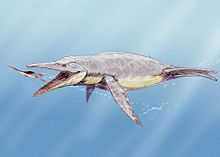
- Samuel W. Williston described a new genus of giant pliosaur based on a skull and vertebrae found in Kansas, naming it Brachauchenius.[20]
- Samuel W. Williston observed that many plesiosaurs were preserved with gastroliths. He speculated that they may have been used for ballast or only accidentally swallowed.[21]
- Barnum Brown hypothesized that plesiosaurs used their gastroliths in a gizzard-like organ to grind up their invertebrate prey since they had no grinding or crushing teeth to do that job for them.[21]
- Harvard paleontologist Charles R. Eastman, "offended" by Brown's claim that plesiosaurs had a gizzard, criticized the idea in print.[21]
- Samuel Williston responded to Eastman, reasserting the evidence for plesiosaur gastroliths by noting that by this time at least 30 specimens containing them had been found.[22]
- Samuel Williston reported the discovery of another Brachauchenius specimen, although this one was discovered in Texas.[23]
- Samuel Williston criticized portrayals of long-necked plesiosaurs as having unnaturally flexible necks.[18]
- Heber Longman described Kronosaurus queenslandicus based on the jaw fragment found there by Andrew Crombie in 1899.[19]
- More Kronosaurus fossils were discovered in central Queensland near the site of the type specimen's discovery.[19]
- Harvard University dispatched a fossil hunting expedition to Queensland, Australia. In Army Downs they discovered a nearly complete specimen of Kronosaurus.[24]
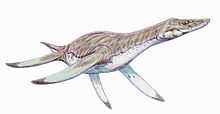

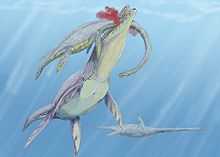
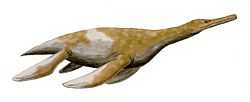
- The "surgeon's photograph" of the Loch Ness monster was hoaxed, cementing the association between plesiosaurs and the mythical beast.[25]
- A large pliosaur skeleton was found on the banks of Russia's Volga River. However, the specimen was damaged during the excavation and only the skull and chest region were successfully extracted.[26]
- A complete specimen of Plesiosaurus conybeari, including preserved soft tissues, was destroyed by a Nazi blitzkrieg against Bristol. Fortunately, a cast of the specimen survived in the British Museum.[27]
- Elmer S. Riggs named a new species of Trinacromerum, T. willistoni. The type specimen had been found by a construction crew working on US Highway 81, who donated it to the University of Kansas Museum of Paleontology.[28]
- Soviet paleontologist Nestor Novozhilov described the Volga pliosaur as a new species, Pliosaurus rossicus.[26]
1950s
- Alfred Sherwood Romer helped mount the Kronosaurus discovered in Queensland by the 1930s Harvard expedition for the University's Museum of Comparative Zoology. The poorly preserved bones required a significant amount of plaster for the restoration, earning the specimen the mocking nickname "Plasterosaurus".[24] The final mount was 42 feet long, probably due to Romer overestimating the number of vertebrae in its spine; a more likely length is about 35 feet.[29]
- Barney H. Newman and Lambert Beverly Halstead Tarlo argued that long-necked plesiosaur flippers could only move horizontally, and while maneuverable, they were confined to surface waters by an inability to dive.[30]
- South Australian opal miners John and Molly Addyman discovered a plesiosaur whose remains had been converted to opal.[31]
- Beverly Halstead reclassified the Volga pliosaur, Pliosaurus rossicus, to the genus Liopleurodon.[26]
- Jane Ann Robinson published a paper on plesiosaur locomotion concluding that they really did swim by "underwater flight" like sea turtles or penguins.[8]
- Robinson publishes follow up research to her previous publication on plesiosaur locomotion.[9] This second paper notably concluded that plesiosaurs were incapable of leaving the water.[32]
- Michael Taylor published a paper concluding that plesiosaurs would have been capable of moving on land after all because their spinal column was too arched for their lungs to collapse.[33]
- Samuel F. Tarsitano and Jürgen Riess published a paper harshly critical of Robsinson's previous work on plesiosaur locomotion. However, while criticizing Robinson's work they were reluctant to make any positive claims of their own, concluding that the details of plesiosaur locomotion were "unknown".[9]
- Richard A. Thulborn published the results of his recent re-examination of the purported plesiosaur embryos discovered by Harry Govier Seeley. Thulborn concluded that Seeley's supposed embryos were actually nodules of mudstone and shale derived from sediments that once filled in a crustacean burrow system and were not even animal body fossils.[16]
- The partial remains of a large pliosaur, initially mistaken for a dinosaur, were discovered near Aramberri, Mexico.[26]
- An South Australian opal miner named Joe Vida discovered the skeleton of a juvenile plesiosaur whose remains had converted to opal. Its preparator, Paul Willis nicknamed it Eric. An entrepreneur named Sid Londish bought the specimen and funded its preparation, but went bankrupt. When the specimen was put up for auction fear spread that a potential buyer might break the specimen down for its gemstone value. A television drive was arranged on behalf of the Australian Museum. The Museum succeeded in raising 340,000 dollars to buy the specimen, whose gemstone value was about $300,000. Eric was later identified as a specimen of Leptocleidus.[34]
- Judith Massare published an analysis of plesiosaur feeding habits. She concluded that the long-necked plesiosauroids ate soft prey. Liopleurodon and its relatives, on the other hand, had teeth resembling those of killer whales and probably ate larger, bonier prey.[23]
- Judy Massare analyzed Mesozoic marine reptile swimming abilities and found that long-necked plesiosaurs would have been significantly slower than pliosaurs due to excess drag incurred from their large round bodies.[35]
- Beverly Halstead published a paper suggesting that plesiosaurs swam using all four flippers paired with an undulatory motion of the body comparable to a sea lion's.[36]
- The world's smallest plesiosaur, between four and five feet in length, was discovered near Charmouth on the Dorset Coast.[37]
- Ralph E. Molnar published suspicion that the "Kronosaurus queenslandicus" specimen discovered by the Harvard expedition might actually be a distinct species.[19]
- Robert T. Bakker nicknamed the long-necked plesiosaurs "swan lizards".[35]
- Robert T. Bakker argued that plesiosaurs suffered several major extinction events throughout the Mesozoic rather than continuously diversifying until the end-Cretaceous mass extinction.[38]
- Robert T. Bakker argued that Dolichorhynchops and its relatives became the most common kind of short-necked plesiosaur in the Cretaceous Western Interior Seaway after the ichthyosaurs went extinct. Further, they convergently evolved many traits similar to those of ichthyosaurs like long snouts and large eyes.[39]
- Tony Thulborn and Susan Turner examined the crushed skull of the long-necked plesiosaur Woolungasaurus and found the presence of tooth marks left by some giant predator. They hypothesized that a Kronosaurus was the culprit.[19][40]
- Glenn W. Storrs formally described the world's smallest plesiosaur for the scientific literature.[37]
- South Dakota School of Mines paleontologist James Martin excavated and described a very young pliosaur specimen.[37] The specimen was located in what would have been the middle of the Cretaceous Western Interior Seaway. It is more plausible to think that this young individual was born in the seaway itself rather than surviving the extremely long swim from shore. So, the specimen provided circumstantial evidence for live birth and possibly even parental care by pliosaurs in the Cretaceous Western Interior Seaway.[41] However, since there were no adult fossils present this interpretation is speculative. Further, the fossil site had been heavily vandalized before discovery by scientists. A large hole was located near the baby pliosaur that could have once held the bones of its mother or other pod members. If so, the act of vandalism could have single handedly robbed science of a conclusion to the contentious debate regarding plesiosaur reproduction.[42]
- An amateur fossil hunter named Simon Carpenter discovered a 7 foot long Pliosaurus brachyspondylus skull in the Blue Circle Cement Works of Westbury, England. More of the skeleton was found in the vicinity and this specimen came to be regarded as the best preserved pliosaur ever found.[43]
- A man named Alan Dawn discovered a previously unknown kind of pliosaur in the Middle Jurassic Oxford Clay of Cambridgeshire, England.[44]
- Ken Carpenter argued against the prevailing trend to treat Trinacromerum and Dolichorhynchops as taxonomic synonyms by observing that thy could be distinguished based on their skull anatomy.[45]
- Arthur R. I. Cruickshank, David M. Martill, and Leslie Noe formally named the new Oxford Clay pliosaur Pachycostasaurus dawni. The researchers noticed that its bones were very dense. So dense, they speculated it would naturally sink in the water and spent most of its time feeding on soft bodied animals living near the seafloor.[44]
- Tamaki Sato and Kazushige Tanabe reported that a partial long necked plesiosaur skeleton had been discovered on the banks of Hokkaido's Obirashibe River. Although they could not identify its exact species, the specimen was significant because its stomach contents provided clues to long-necked plesiosaur diets. This individual's gut preserved the beaks of thirty small ammonites.[46]
- John A. Long bemoaned the fact that the putative "Kronosaurus queenslandicus" uncovered by a Harvard team during the early 1930s had still not been formally described for the scientific literature.[19]
21st century
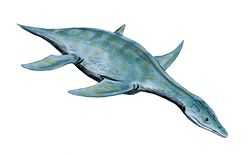
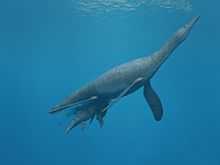
- Theagarten Lingham-Soliar published further criticism of Robinson's interpretation of the biomechanics of plesiosaur locomotion.[47]
- November: The Advertiser, a newspaper based in Adelaide, Australia bought the Addyman opalized plesiosaur specimen for $25,000 and donated it to the South Australian Museum. A paleontologist at the museum named Ben Kear identified it as a member of the genus Leptocleidus. The two foot long specimen was the smallest specimen of the genus ever found and probably a baby.[31]
- A paper by David J. Cicimiurri and Michael J. Everhart noted that by this point in time at least fifteen different plesiosaur specimens were known with preserved stomach contents. The most common component of these specimen's diets were cephalopods, followed by fish.[48]
- Cicimurri and Everhart disputed the hypothesis that plesiosaurs used their gastroliths for ballast on the grounds that swallowing and vomiting such stones would be relatively difficult for the long-necked forms and their feeding grounds may have been hundreds of miles from sources of stones. Instead Cicimurri and Everhart argued that the gastroliths were digestive aids.[49]
- Noe published another study of Pachycostasaurus. He changed his mind regarding its diet. Where previously he believed it to feed on soft-bodied animals, the robust and "heavily ornamented" build of its teeth suggested it fed on harder, bonier prey.[44]
- September: Eberhard Frey, Celine Bachy, and Wolfgang Stinnesbeck gave a presentation on the Aramberri pliosaur remains to the European Workshop on Vertebrate Paleontology in Florence, Italy. The paleontologists could not identify its species.[50]
2001-2002
- Robin O'Keefe publishes a series of papers examining the aspect ratios of plesiosaur flippers and comparing them to the wings of birds, bats, and aircraft. O'Keefe concluded that long-necked plesiosaurs were long distance swimmers, while pliosaurs were more maneuverable.[51]
- December 30th: The BBC began making sensational claims about the Aramberri pliosaur, claiming that the unidentified pliosaur was a Liopleurodon, that it was 65 feet long, that its teeth were the size of machetes, and its jaws powerful enough to crush granite.[52]
- The University of Nebraska led the excavation of a long-necked plesiosaur skeleton on local Santee Sioux land.[53] The Santee people requested that the skeleton be mounted and displayed with a plaque acknowledging them as the source of the fossils and as having given permission for the museum to display the remains. However, the museum claims it could not honor the request as it did not have the funding to mount the skeleton for display, and it further claimed that the land the fossils were recovered from was of "disputed" ownership.[54]
- F. Robin O'Keefe and Luis M. Chiappe concluded the debate on plesiosaur reproduction, reporting the discovery of a gravid female plesiosaur with a single large embryo preserved inside her. They concluded that like marine mammals, but unlike many reptiles, plesiosaurs had a K-selected reproductive strategy.[10]
See also
- History of paleontology
- Ichthyosaur
- List of plesiosaurs
- Marine reptile
- Mosasaur
- Timeline of paleontology
Footnotes
- ↑ 1.0 1.1 Ellis (2003); "Introduction: Isn't That the Loch Ness Monster?", page 3.
- ↑ Ellis (2003); "The Marine Reptiles: An Overview", page 20.
- ↑ 3.0 3.1 Ellis (2003); "The Marine Reptiles: An Overview", page 21.
- ↑ Ellis (2003); "The Plesiosaurs," page 118.
- ↑ Ellis (2003); "The Plesiosaurs," page 119.
- ↑ Ellis (2003); "The Plesiosaurs," page 136.
- ↑ Ellis (2003); "The Plesiosaurs," page 137.
- ↑ 8.0 8.1 Ellis (2003); "The Plesiosaurs," page 138.
- ↑ 9.0 9.1 9.2 Ellis (2003); "The Plesiosaurs," page 139.
- ↑ 10.0 10.1 O'Keefe and Chiappe (2011); "Abstract," page 870.
- ↑ For the mythical creatures as Thunder Birds and Water Monsters, see Mayor (2005); "The Stone Medicine Bone, Pawnee Territory," page 178. For plesiosaurs as a specific source of these legends, see Mayor (2005); "Cheyenne Fossil Knowledge," page 211.
- ↑ Ellis (2003); "The Plesiosaurs," page 123.
- ↑ Ellis (2003); "The Marine Reptiles: An Overview", page 37.
- ↑ Ellis (2003); "The Pliosaurs," page 166.
- ↑ Ellis (2003); "The Marine Reptiles: An Overview", pages 21-22.
- ↑ 16.0 16.1 Ellis (2003); "The Plesiosaurs," page 149.
- ↑ Ellis (2003); "The Pliosaurs," pages 188-189.
- ↑ 18.0 18.1 Ellis (2003); "The Plesiosaurs," page 153.
- ↑ 19.0 19.1 19.2 19.3 19.4 19.5 Ellis (2003); "The Pliosaurs," page 176.
- ↑ Ellis (2003); "The Pliosaurs," page 183.
- ↑ 21.0 21.1 21.2 Ellis (2003); "The Plesiosaurs," page 156.
- ↑ Ellis (2003); "The Plesiosaurs," pages 156-157.
- ↑ 23.0 23.1 Ellis (2003); "The Pliosaurs," page 184.
- ↑ 24.0 24.1 Ellis (2003); "The Pliosaurs," page 175.
- ↑ Ellis (2003); "The Plesiosaurs," page 121.
- ↑ 26.0 26.1 26.2 26.3 Ellis (2003); "The Pliosaurs," page 181.
- ↑ Ellis (2003); "The Plesiosaurs," page 161.
- ↑ Ellis (2003); "The Pliosaurs," page 188.
- ↑ Ellis (2003); "The Pliosaurs," pages 175-176.
- ↑ Ellis (2003); "The Plesiosaurs," page 154.
- ↑ 31.0 31.1 Ellis (2003); "The Pliosaurs," page 174.
- ↑ Ellis (2003); "The Plesiosaurs," pages 139-140.
- ↑ Ellis (2003); "The Plesiosaurs," page 142.
- ↑ Ellis (2003); "The Pliosaurs," page 166.
- ↑ 35.0 35.1 Ellis (2003); "The Plesiosaurs," page 152.
- ↑ Ellis (2003); "The Plesiosaurs," page 143.
- ↑ 37.0 37.1 37.2 Ellis (2003); "The Plesiosaurs," page 150.
- ↑ Ellis (2003); "The Plesiosaurs," page 163.
- ↑ Ellis (2003); "The Pliosaurs," pages 189-191.
- ↑ Thulborn, T; Turner, S (1993). "An elasmosaur bitten by a pliosaur". Modern Geology 18: 489-501.
- ↑ Ellis (2003); "The Plesiosaurs," pages 150-151.
- ↑ Ellis (2003); "The Plesiosaurs," page 151.
- ↑ Ellis (2003); "The Pliosaurs," page 169.
- ↑ 44.0 44.1 44.2 Ellis (2003); "The Pliosaurs," page 191.
- ↑ Ellis (2003); "The Pliosaurs," page 189.
- ↑ Ellis (2003); "The Plesiosaurs," pages 155-156.
- ↑ Ellis (2003); "The Plesiosaurs," page 141.
- ↑ Ellis (2003); "The Plesiosaurs," page 155.
- ↑ Ellis (2003); "The Plesiosaurs," page 159.
- ↑ Ellis (2003); "The Pliosaurs," pages 181-182.
- ↑ Ellis (2003); "The Plesiosaurs," pages 142-143.
- ↑ Ellis (2003); "The Pliosaurs," page 182.
- ↑ Mayor (2005); "Cultural and Historical Conflicts," page 303.
- ↑ Mayor (2005); "Cultural and Historical Conflicts," pages 303-304.
References
- Ellis, Richard, (2003) Sea Dragons - Predators of the Prehistoric Oceans. University Press of Kansas. ISBN 0-7006-1269-6.
- Mayor, Adrienne. Fossil Legends of the First Americans. Princeton University Press. 2005. ISBN 0-691-11345-9.
- O'Keefe, F.R.; Chiappe, L.M. (2011). "Viviparity and K-selected life history in a Mesozoic marine plesiosaur (Reptilia, Sauropterygia)". Science 333 (6044): 870–873. doi:10.1126/science.1205689. PMID 21836013.
